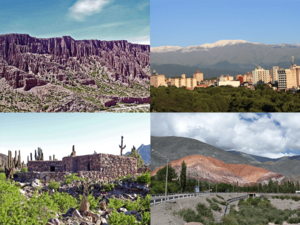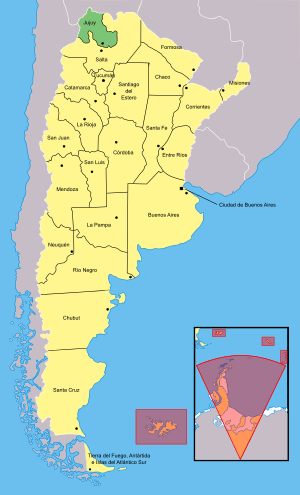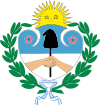Jujuy Province facts for kids
Quick facts for kids
Jujuy
|
|||
|---|---|---|---|

Clockwise from top: Quebrada de Humahuaca, San Salvador de Jujuy, Pucará de Tilcara, and the Hill of Seven Colors
|
|||
|
|||

Location of Jujuy within Argentina
|
|||
| Country | Argentina | ||
| Capital | San Salvador de Jujuy | ||
| Departments | 16 | ||
| Municipalities and municipal commissions | 61 | ||
| Area | |||
| • Total | 53,219 km2 (20,548 sq mi) | ||
| Population
(2010)
|
|||
| • Total | 672,260 (Ranked 14th) | ||
| • Density | 12.6/km2 (33/sq mi) | ||
| Demonym(s) | jujeño | ||
| Time zone | UTC−3 (ART) | ||
| ISO 3166 code | AR-Y | ||
Jujuy is a province in the far northwest of Argentina. It shares borders with Chile and Bolivia. The only other Argentine province next to Jujuy is Salta, to its east and south.
Contents
History of Jujuy Province
Before Europeans arrived, people lived in Jujuy. They later mixed with the Incas as the Inca lands grew. These early people farmed and raised guanacos, which are like small llamas.
They lived in huts made of mud. They also built strong stone forts to protect their villages. One famous example is Pucará de Tilcara, where "Pucará" means "Fortress."
In 1593, a small town was built in the Jujuy valley. This was thanks to Francisco de Asgaranaz y Murguía. Even with attacks from local groups like the calchaquíes, the town grew and became stronger.
Later, in the late 1600s, customs duties were moved to Jujuy. These were taxes on goods going to the Viceroyalty of Peru. But when the Viceroyalty of the Río de la Plata was created, Jujuy lost its importance. Its population started to shrink.
During the May Revolution, Argentina fought for its independence. Many battles happened in Jujuy. This was because Spanish forces were strong in Peru. The people of Jujuy had to leave their homes in a big event called the Jujuy Exodus. General Manuel Belgrano led this. They burned their crops and homes so the Spanish could not use them. This was called a "scorched earth" policy.
Eventually, the Spanish gave up. But the war badly hurt the area's economy. After some local fights, Jujuy separated from Tucumán and Salta. It slowly started to get better. By the late 1800s, the sugarcane industry became very important. By the early 1900s, a railway connected Jujuy to Buenos Aires and La Paz, Bolivia.
Industry grew even more in the 1940s. The first metal-making furnace in Argentina was built here. Then, in 1969, petroleum (oil) was found by the state-owned company YPF.
Geography and Climate of Jujuy
Jujuy has three main types of land. Most of the province is the Altiplano. This is a high plateau about 3,500 meters (11,500 feet) high. Some peaks reach 5,000 meters (16,400 feet).
The Grande River of Jujuy flows through the Quebrada de Humahuaca. This is a deep canyon with heights between 1,000 and 3,500 meters (3,300 to 11,500 feet). To the southeast, the sierras (mountain ranges) go down to the Gran Chaco region.
The big differences in height and climate create various landscapes. You can find dry desert areas like the Salinas Grandes salt mines. There are also subtropical Yungas jungles.
Most of Jujuy's land is dry or semi-desert. But the El Ramal valley, fed by the San Francisco River, is an exception. The Grande River and San Francisco River get their water from the Bermejo River. Other rivers like the San Juan, La Quiaca, Yavi, and Sansana flow into the Pilcomayo River.
Economy and Industries
The main farm product in Jujuy is sugarcane. Making sugar from it creates more than half of the province's total production. It also makes 30% of all sugar in Argentina.
The second most important farm product is tobacco. It is grown in the southeastern valley and is a major national crop. Other crops include beans, citrus fruits, and tomatoes. Local people also grow other vegetables.
Jujuy is Argentina's second-largest producer of iron. This iron is used to make steel at the Altos Hornos Zapala furnace. Other industries include mining for building materials. Petroleum (oil) is extracted at Caimancito. Salt is produced from the Salinas Grandes salt basin. Paper is also made using trees from Jujuy's forests. This makes up 20% of the province's industrial output.
Raising cattle and goats for milk and wool is a smaller activity. Raising llamas, vicuñas, and guanacos is also done on a smaller scale.
Tourism and Attractions
Tourism is an important and growing activity in Jujuy. Many visitors come to explore the province. Most tourists start their trip in San Salvador de Jujuy. The Horacio Guzmán international airport is 34 km (21 miles) from San Salvador. It connects Jujuy with Buenos Aires, Córdoba, and some places in Bolivia.
Tourists love the amazing colors and shapes of the land. They are also drawn to Jujuy's strong local cultures. The Aymará and Quechua cultures live side-by-side here. Old ruins from the Incas are also well-preserved.
Popular places to visit include the Quebrada de Humahuaca and its Cerro de los Siete Colores (Hill of Seven Colors). Visitors also go to Pucará de Tilcara, Salinas Grandes, and many small towns. Less common places to visit are the Calilegua National Park in the Yungas jungle, La Quiaca, Laguna de Pozuelos, and Laguna Guayatayoc.
Images for kids
-
Ruins of the Pucará near Tilcara
-
Cerro de los Siete Colores, Purmamarca
-
Calle de Tilcara, Jujuy, Argentina
-
Patio inside the Jujuy Cathedral, San Salvador de Jujuy.
See also
 In Spanish: Provincia de Jujuy para niños
In Spanish: Provincia de Jujuy para niños















